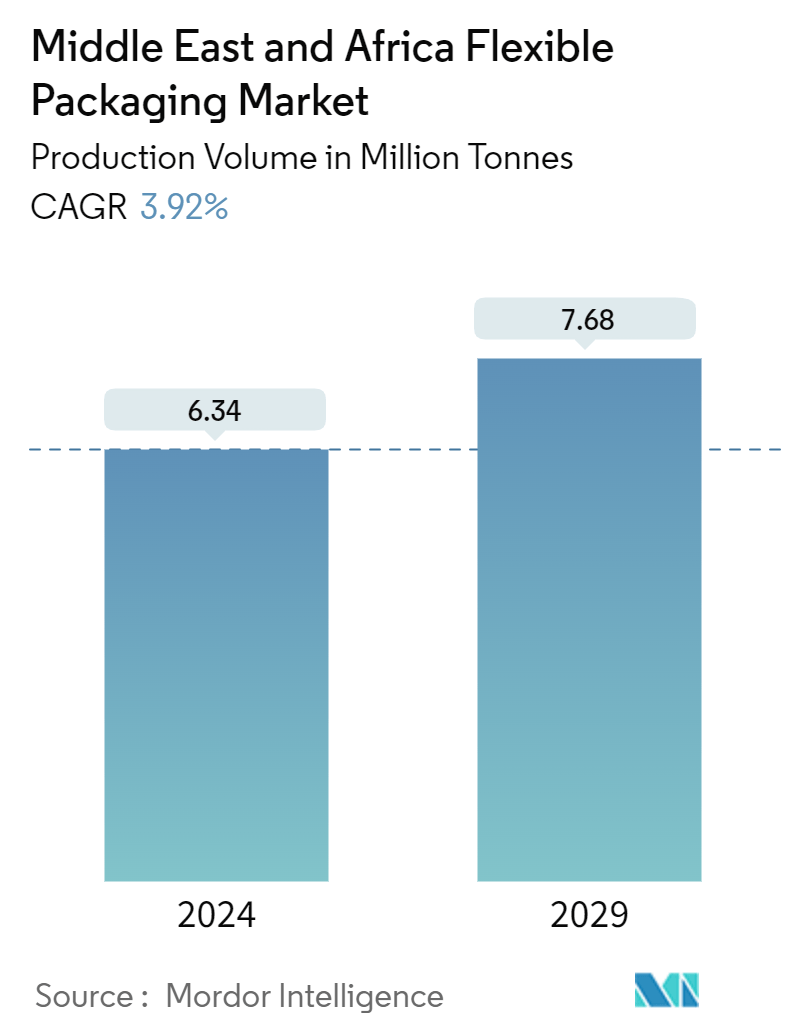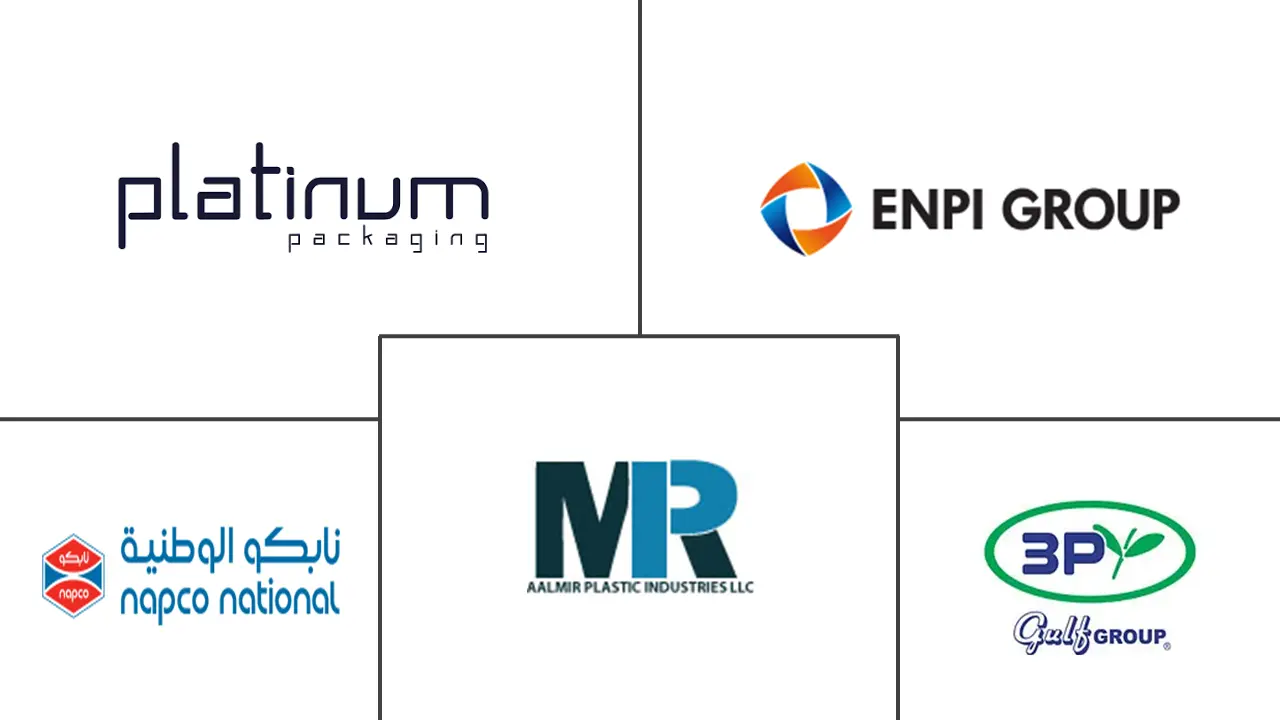Market Size of Middle East And Africa Flexible Packaging Industry

| Study Period | 2019 - 2029 |
| Base Year For Estimation | 2023 |
| Forecast Data Period | 2024 - 2029 |
| Market Volume (2024) | 6.34 Million tonnes |
| Market Volume (2029) | 7.68 Million tonnes |
| CAGR (2024 - 2029) | 3.92 % |
| Market Concentration | Low |
Major Players
*Disclaimer: Major Players sorted in no particular order |
Middle East and Africa Flexible Packaging Market Analysis
The Middle East And Africa Flexible Packaging Market size in terms of production volume is expected to grow from 6.34 Million tonnes in 2024 to 7.68 Million tonnes by 2029, at a CAGR of 3.92% during the forecast period (2024-2029).
Flexible packaging allows more economical and customizable options for packaging products. It is particularly useful in industries requiring versatile packaging, including food and beverage, personal care, and pharmaceutical industries. Flexible packaging has grown popular due to its high efficiency and cost-effectiveness.
- The packaging business in the region has experienced consistent growth over the last decade due to changing consumer expectations and a rising population. Sustainability and environmental aspects might continue to be emphasized in the region as the market is witnessing various innovations in packaging materials. Increased demand for recyclable and sustainable packaging materials, such as paper and cardboard, recycled PET (rPET), and bioplastics, are driving market growth.
- Moreover, the changing consumer food preferences in the United Arab Emirates have created significant growth opportunities in the packaging industry, especially for the food and beverage industry. According to a report by Alpen Capital, a financial institute in the United Arab Emirates, the food industry in the Middle East and African region is estimated to grow due to its strategic location and growing population. Post-pandemic, the surge in online food delivery has enhanced the demand for flexible packaging such as wraps, sleeves, labels, and others, driving industry growth.
- Additionally, the increasing influence of Western eating habits among domestic consumers has boosted the demand for packaged foods. This trend is further supported by immigrants, tourists, and young consumers driving the demand for ready-to-eat, processed, and frozen foods.
- The lighter weight, reduced material use, and lower shipping cost of stand-up pouches than the rigid packaging benefit the packaged food producers. With the beverage industry increasingly consuming pouches in the region, the demand from the market is expected to increase.
- The Middle East faces significant challenges in the flexible packaging industry due to its limited recycling infrastructure. This issue has become increasingly prominent as sustainability concerns gain traction globally and within the region. Despite growing awareness of the environmental problems and implementing various government initiatives to promote recycling and waste reduction, the need for adequate recycling facilities and systems continues to pose a substantial obstacle. This situation creates a complex dynamic for flexible packaging manufacturers and users in the region as they strive to balance market demands with emerging sustainability requirements.
Middle East and Africa Flexible Packaging Industry Segmentation
Flexible packaging refers to any package or portion of a package that can easily change its shape when filled or being utilized. Flexible packaging is made from combinations of paper, plastic, film, aluminum foil, or other materials and consists of bags, pouches, liners, wraps, roll stock, and other flexible items.
The Middle East and Africa flexible packaging market is segmented by material type (plastics (Polyethylene (PE), Polypropylene (PP), Polyethylene terephthalate (PET), other plastics (PVC, PA, etc.)), paper, aluminum, compostable materials (PLA, PBS, PHA, PBAT, etc.), product type (pouches, films and wraps [thermoforming film, stretch films, shrink film, cling film], labels and sleeves, lidding and liners, blister packaging), end-user verticals (food, beverages, pharmaceuticals, cosmetics and personal care, household care, pet care, tobacco, other end-user industries (electronics, chemicals, agricultural products, etc.)), and Country (Saudi Arabia, United Arab Emirates, Morocco, Egypt, South Africa, and the rest of the Middle East and Africa). The report offers market forecasts and size in volume (tonnes) for all the above segments.
| By Material Type | ||||||
| ||||||
| Paper | ||||||
| Aluminum | ||||||
| Compostable Materials (PLA, PBS, PHA, PBAT, etc.) |
| By Product Type | ||||||
| Pouches And Bags | ||||||
| ||||||
| Labels And Sleeves | ||||||
| Lidding And Liners | ||||||
| Blister Packaging |
| By End-user Industry | |
| Food | |
| Beverages | |
| Pharmaceuticals | |
| Cosmetics And Personal Care | |
| Household Care | |
| Pet Care | |
| Tobacco | |
| Other End-user Industries (Electronics, Chemicals, Agricultural Products etc.) |
| By Country*** | |
| Saudi Arabia | |
| United Arab Emirates | |
| Morocco | |
| Egypt | |
| South Africa |
Middle East And Africa Flexible Packaging Market Size Summary
The Middle East and Africa Flexible Packaging Market is poised for significant growth, driven by the increasing demand for versatile and cost-effective packaging solutions across various industries such as food and beverage, personal care, and pharmaceuticals. The market's expansion is fueled by changing consumer preferences, a rising population, and the growing popularity of sustainable packaging materials like recycled PET and bioplastics. The region's strategic location and the surge in online food delivery services have further amplified the demand for flexible packaging, particularly in the food and beverage sector. However, challenges such as limited recycling infrastructure and the need for sustainable practices continue to shape the market dynamics, requiring manufacturers to balance innovation with environmental considerations.
Saudi Arabia emerges as a key player in the region's flexible packaging market, benefiting from its strategic position and well-developed infrastructure. The country's economic reforms and strategic initiatives have attracted global attention, making it a hub for trade and investment. The demand for flexible packaging solutions is rising, particularly in sectors like food, retail, and pharmaceuticals, driven by changing consumer lifestyles and preferences for convenience and extended shelf life. The market is characterized by fragmentation, with several regional players competing to meet the evolving demands. Recent strategic moves by companies like Huhtamaki and Napco National highlight the ongoing efforts to enhance operational capabilities and market presence, reflecting the region's growing importance in the global packaging industry.
Middle East And Africa Flexible Packaging Market Size - Table of Contents
-
1. MARKET INSIGHTS
-
1.1 Market Overview
-
1.2 Industry Ecosystem Analysis Suppliers, Material Manufacturers, etc.
-
1.3 Industry Attractiveness - Porter's Five Forces Analysis
-
1.3.1 Bargaining Power of Suppliers
-
1.3.2 Bargaining Power of Buyers
-
1.3.3 Threat of New Entrants
-
1.3.4 Intensity of Competitive Rivalry
-
1.3.5 Threat of Substitute Products
-
-
1.4 Import-Export Analysis
-
-
2. MARKET SEGMENTATION
-
2.1 By Material Type
-
2.1.1 Plastics
-
2.1.1.1 Polyethene (PE)
-
2.1.1.2 Polypropylene (PP)
-
2.1.1.3 Polyethylene Terephthalate (PET )
-
2.1.1.4 Other Plastics (PVC, PA, etc.)
-
-
2.1.2 Paper
-
2.1.3 Aluminum
-
2.1.4 Compostable Materials (PLA, PBS, PHA, PBAT, etc.)
-
-
2.2 By Product Type
-
2.2.1 Pouches And Bags
-
2.2.2 Films And Wraps
-
2.2.2.1 Thermoforming Film
-
2.2.2.2 Stretch Films
-
2.2.2.3 Shrink Film
-
2.2.2.4 Cling Film
-
-
2.2.3 Labels And Sleeves
-
2.2.4 Lidding And Liners
-
2.2.5 Blister Packaging
-
-
2.3 By End-user Industry
-
2.3.1 Food
-
2.3.2 Beverages
-
2.3.3 Pharmaceuticals
-
2.3.4 Cosmetics And Personal Care
-
2.3.5 Household Care
-
2.3.6 Pet Care
-
2.3.7 Tobacco
-
2.3.8 Other End-user Industries (Electronics, Chemicals, Agricultural Products etc.)
-
-
2.4 By Country***
-
2.4.1 Saudi Arabia
-
2.4.2 United Arab Emirates
-
2.4.3 Morocco
-
2.4.4 Egypt
-
2.4.5 South Africa
-
-
Middle East And Africa Flexible Packaging Market Size FAQs
How big is the Middle East And Africa Flexible Packaging Market?
The Middle East And Africa Flexible Packaging Market size is expected to reach 6.59 million tonnes in 2025 and grow at a CAGR of 3.92% to reach 7.99 million tonnes by 2030.
What is the current Middle East And Africa Flexible Packaging Market size?
In 2025, the Middle East And Africa Flexible Packaging Market size is expected to reach 6.59 million tonnes.

